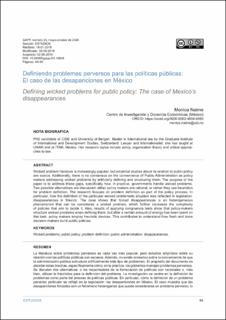Defining wicked problems for public policy: The case of Mexico’s disappearances
Journal article, Peer reviewed
Published version

Åpne
Permanent lenke
https://hdl.handle.net/11250/2727323Utgivelsesdato
2020Metadata
Vis full innførselSamlinger
- Faculty of Law [2478]
- Registrations from Cristin [9766]
Originalversjon
10.24965/gapp.i23.10648Sammendrag
Wicked problem literature is increasingly popular, but empirical studies about its relation to public policy are scarce. Additionally, there is no consensus on the convenience of Public Administration as policy makers addressing wicked problems by artificially defining and structuring them. The purpose of the paper is to address these gaps, specifically how, in practice, governments handle wicked problems. Two possible alternatives are discussed: either policy makers are rational, or rather they use heuristics for problem definition. The research focuses on problem definition as part of the policy process. In particular, how the definition of the particular wicked problematic situation was reflected in legislation: disappearances in Mexico. The case shows that forced disappearances is an heterogeneous phenomenon that can be considered a wicked problem, which further increases the complexity of policies that aim to tackle it. Also, results of applying congruence tests show that policy-makers structure wicked problems when defining them, but after a certain amount of energy has been spent on this task, policy makers employ heuristic devices. This contributes to understand how flesh and bone decision-makers build public policies.
